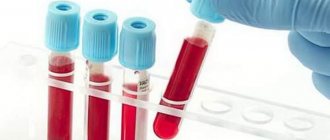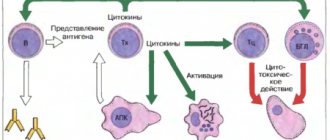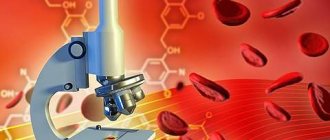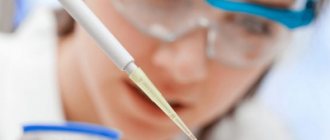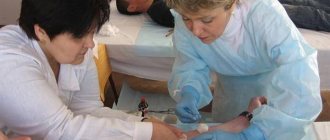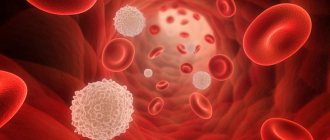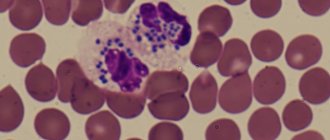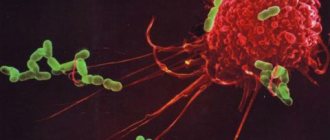General information
The number of leukocytes in the blood is not a constant value; it increases with emotional or physical stress, sudden changes in ambient temperature, intake of protein foods, and also with diseases. In the case of disease, leukocytosis is pathological, while an increase in the number of leukocytes in a healthy person is physiological leukocytosis.
A significant increase (up to several hundred thousand) in the number of leukocytes usually indicates a serious blood disease - leukemia, and an increase to several tens of thousands indicates an inflammatory process.
Causes of violations for various categories of the population
The level of white blood cells in the blood increases rapidly with leukemia. This is one of the most dangerous conditions manifested by changes in blood composition. With this pathology, the indicators rise tens of times (from 100 to 300*10⁹/l). It is characteristic that the level of protective cells can also sharply decrease to critical levels (down to 0.1*10⁹/l).
In case of sepsis, abscesses, purulent peritonitis, which are accompanied by widespread infection, the value of leukocytes reaches 80*10⁹/l. An increase to 20‒25*10⁹/l occurs with appendicitis. A sharp increase in the indicator indicates the development of complications (necrosis, peritonitis).
Most often, the number of colorless bodies increases against the background of infectious and inflammatory diseases of the respiratory, digestive, and urinary systems. A moderate but prolonged increase accompanies chronic inflammation of internal organs, joints, muscles, as well as helminthiases, pathologies of the liver and gall bladder.
Useful information: Urobilinogen in urine is increased: what does this mean, reasons, norms for adults and children. What is the danger of the condition
Leukocytosis in men
Leukocytosis in representatives of the stronger half of humanity most often raises suspicions of prostatitis, inflammation of the testicles, chronic pancreatitis (due to a tendency to these pathologies). An elevated white blood cell count in a man can be caused by diabetes, tumor growth, or a previous heart attack or stroke (even if the damage is minimal). To distinguish pathological conditions, the doctor will definitely prescribe a repeat test and a general examination.
Leukocytosis in women
A slight increase in leukocytes is detected before menstruation. The level of protective cells stabilizes after bleeding.
Due to pregnancy, fluctuations are also possible. In the first weeks the values increase, then return to normal. The peak coincides with the moment of chorion implantation into the uterine wall. In the next 2 months of gestation, the leukocyte level should be normal. An increase requires attention, as it may signal chronic or acute inflammation of the pelvic organs, which is dangerous for the fetus.
The next growth spurt in colorless bodies is observed in the 2nd trimester. A slightly elevated level persists for the entire remaining period of gestation, as well as for 2 weeks after delivery. If it was performed by cesarean section, an additional increase in leukocytes occurs (which is associated with blood loss and the presence of a wound surface). After natural childbirth, an increase in the level of leukocytes in the first 6 weeks is also allowed. During pregnancy, changes should be within normal limits. A serious increase in concentration indicates pathology.
In the fair sex, leukocytosis is observed with mastitis and mastopathy. The second option requires close attention, since benign breast tumors can degenerate into malignant ones. Venereal diseases and nonspecific gynecological inflammations are also considered provocateurs. In women over forty years of age, cholecystitis often occurs.
Disorders in children
The child's body is sensitive to various changes around and inside. The level of leukocytes increases rapidly against the background of viral and bacterial infections and persists for 1–2 weeks after illness. A slightly increased number of white cells may accompany helminthiasis (therefore, if abnormalities are detected, the doctor will prescribe a test for parasites first).
The child’s immunity reacts with leukocytosis to errors in nutrition (lack of vitamins and minerals, predominance of foods rich in carbohydrates and protein). Failures are provoked by stress (physical and emotional), lack of rest and night sleep.
Doctors prescribe a general blood test for children more often. It is simply necessary to pay attention to the indicators of leukocytes, since strong deviations can be the first signals of diseases of the hematopoietic organs and lymphatic system.
Causes of leukocytosis
The main causes of leukocytosis include:
- Acute infection is the most common cause of leukocytosis;
- Chronic inflammation. As leukocytes fight against dangerous bacteria that have entered the body, an inflammatory process begins. Under some conditions, this process can become chronic, resulting in a permanently elevated level of leukocytes;
- Tissue damage due to trauma;
- Poor nutrition;
- Immune system overreaction - may develop in people who suffer from severe allergies or autoimmune diseases;
- Disorders associated with bone marrow damage, because it is in it that leukocytes are produced;
- Stress, prolonged or very strong psychological stress;
- Some medications.
The most common causes of leukocytosis in children:
- Infectious diseases;
- Poor nutrition;
- Excessive physical activity;
- Stress.
In addition, we must not forget that, although rare, acute leukemia can be the cause of leukocytosis in children.
What it is?
These white blood cells, the most important components of the human immune system, are formed from stem cells in the bone marrow, in the spleen, lymph nodes and tonsils. They protect the body through phagocytosis - the absorption and dissolution of pathogenic microorganisms, and also produce antibodies that interact with the causative agent of the disease or infection. They can quickly move throughout the body and penetrate through the walls of capillaries into the intercellular space. They live, as a rule, up to 12 days, then self-destruct and are excreted from the body. A clinical blood test determines the total number of white blood cells, but for a more accurate diagnosis, a test is performed to determine the concentration of each type of white blood cell.
Types of leukocytosis
Leukocytosis can be true or absolute (with an increase in leukocytes or the mobilization of their reserves from the bone marrow), as well as redistributive or relative (an increase in the number of leukocytes as a result of blood thickening or their redistribution in the vessels).
The following types of leukocytosis are also distinguished:
1. Physiological leukocytosis: observed after physical activity, eating, etc.;
2. Pathological symptomatic leukocytosis: occurs in certain infectious diseases, purulent-inflammatory processes, as well as as a result of a certain reaction of the bone marrow to tissue breakdown, which was caused by a toxic effect or circulatory disorder;
3. Short-term leukocytosis: occurs as a result of a sudden “release” of leukocytes into the blood, for example, during stress or hypothermia. In such cases, the disease is reactive in nature, i.e. disappears along with the cause of its occurrence;
4. Neurophilic leukocytosis. This condition is most often caused by an increase in the formation and release of neutrophils into the blood, while an increase in the absolute number of leukocytes is noted in the vascular bed. Observed in acute infection, chronic inflammation, as well as myeloproliferative diseases (blood diseases);
5. Eosinophilic leukocytosis develops as a result of accelerated formation or release of eosinophils into the blood. The main causes are allergic reactions, including to foods and medications;
6. Basophilic leukocytosis is caused by an increase in the formation of basophils. Observed during pregnancy, nonspecific ulcerative colitis, myxedema;
7. Lymphocytic leukocytosis is characterized by an increase in lymphocytes in the blood. Observed in chronic infections (brucellosis, syphilis, tuberculosis, viral hepatitis) and some acute infections (whooping cough);
8. Monocytic leukocytosis is extremely rare. It is observed in malignant tumors, sarcoidosis, and some bacterial infections.
Causes
Today, there are many causes of leukocytosis, which represent a number of serious diseases and some pathological conditions of the body. Today the main provocateurs of this disease are considered to be:
- Poor nutrition.
- Inflammatory process. When leukocytes fight against harmful bacteria, inflammation begins. In some diseases (usually chronic), the percentage of leukocytes is constantly increased.
- Infectious process. The most common cause of leukocytosis today is considered to be infection (chicken pox, pneumonia, etc.).
- Tissue damage due to various injuries or minor injuries (burn, scratch, cancer).
- Disorders that are associated with the bone marrow.
- Immune reaction. Leukocytosis very often develops in people who suffer from asthma or severe allergies.
- Medicines used in the treatment of mental disorders, cancer, respiratory diseases and various inflammations.
- Temporary (but very strong) or prolonged psychological tension, stress.
- Hereditary predisposition.
As for leukocytosis in children, the most common causes are: increased physical activity, poor diet, childhood infections and stress. Very often, when symptoms of the disease are detected in children, diseases of the cardiovascular system or malignant tumors are also detected.
Today there are several types of disease, which we will now talk about.
- Short-term leukocytosis. This type of illness develops when there is a sudden release of white blood cells into the blood (for example, stress). In such situations, the disease disappears along with the provocateur of its occurrence. This form of the disease is observed in typhus, scarlet fever, diphtheria, septic diseases and lobar pneumonia.
- Pathological symptomatic appearance. It usually develops during purulent-inflammatory processes and some infections.
- Physiological leukocytosis can occur after eating, heavy physical exertion, etc.
- The eosinophilic type of the disease develops as a result of the formation or release of eosinophils into the blood. The main causes are medications and allergic reactions (even to vaccines).
- Neutrophilic leukocytosis is caused by a high level of formation or release of neutrophils into the blood. This type of disease is observed in chronic inflammation, acute infections and myeloproliferative diseases.
- The lymphocytic form of leukocytosis is characterized by a high percentage of lymphocytes in the blood. It is observed in chronic and some acute infections.
- The basophilic type of the disease is characterized by an increase in the formation of basophils. Occurs with nonspecific ulcerative colitis, pregnancy and myxedema.
- Monocytic leukocytosis is very rare. It develops in sarcoidosis, malignancies and some bacterial infections.
Symptoms of leukocytosis
Leukocytosis is not an independent disease, and therefore its symptoms coincide with the signs of the diseases that caused it. In children, leukocytosis is often asymptomatic, which is why doctors recommend that parents periodically have their child’s blood tested in order to detect abnormalities in the composition of the blood at an early stage.
The most dangerous, although the rarest type of leukocytosis is leukemia, or blood cancer, and therefore it is necessary to know its symptoms so as not to miss the onset of the disease. So, with leukemia, the common symptoms of leukocytosis are as follows:
- Unreasonable malaise, weakness, fatigue;
- Increased body temperature, increased sweating at night;
- Spontaneous hemorrhages, frequent formation of bruises;
- Fainting, dizziness;
- Pain in the legs, arms and abdomen;
- Labored breathing;
- Poor appetite;
- Unexplained weight loss.
If you find yourself with two or more of the listed signs, you should consult a doctor and take a blood test.
Leukocytosis in children
Unfortunately, leukocytosis occurs in children no less frequently than in adults, and there are significant differences from the leukocytosis experienced by adults. This is due to the fact that in childhood the immune system is poorly developed. The presence of a diagnosis is indicated by an increased level of leukocytes. Leukocytosis in newborns is within the normal range of 9-30x109/l, and at the age of up to three years the norm is considered to be 6-17x109/l, and at the age of up to 10 years - 6-11x109/l. When donating blood, deviations from the above norms will be evidence of the presence of the disease.
The younger the child is, the greater the likelihood of leukocytosis. This is facilitated by increased physical activity, stress, hereditary predisposition, poor nutrition, changes in temperature and many other factors. However, all these factors provoke only a slight change in the body, and after a certain time all indicators return to normal. Even having the flu helps increase the number of white blood cells. However, if you start timely treatment of ARVI, then literally in a few days the number of leukocytes will return to normal.
Often, when leukocytosis is detected, malignant tumors and diseases of the cardiovascular system are detected. Despite this, the disease itself does not pose a significant threat, since the child’s blood count changes quickly and leukocytes can be easily normalized.
Newborns have a greater predisposition to leukocytosis due to the inflammatory infectious process. Also, high leukocytosis is evidence of the presence of neoplasms and cardiovascular diseases. However, you can find cases where the disease is considered to be a normal physiological process.
Early detection of leukocytosis in childhood will allow treatment to begin at the initial stage, achieving maximum effect. Otherwise, serious consequences may arise. The formation of a pathological form of leukocytosis can be provoked by:
— childhood infectious diseases;
- inflammatory processes accompanied by purulent foci;
- large-scale burns;
— oncological diseases;
- large blood loss;
- diseases of the cardiovascular system.
Leukocytosis is not considered a disease. This is rather a criterion for assessing the inflammatory process.
Treatment of leukocytosis
Treatment methods for leukocytosis depend entirely on the disease that caused it. For infectious processes, antibiotics and anti-inflammatory drugs are usually prescribed; antihistamines and steroids can be prescribed to relieve an allergic reaction. Chemotherapy drugs are used to treat leukemia. In some cases, leukopheresis may be prescribed - the extraction of leukocytes from the blood, after which the blood is transfused back to the patient.
It should be remembered that treatment of leukocytosis cannot be carried out without identifying the cause that caused it.
Video from YouTube on the topic of the article:
Jeanne Nickels Blog | Food is like medicine
Welcome, dear friends, to the Annakels.com blog. We continue to study the connection between our health and nutrition. I recently learned a new concept for myself - food leukocytosis. I had never encountered this phenomenon before. But it turned out that each of us voluntarily provokes such a reaction in our body several times a day.
What causes food leukocytosis? Is it really dangerous to human health? And, if yes, then how to avoid it?
In the general sense of the word , leukocytosis
called a change in the cellular composition of the blood, characterized by an increase in the number of leukocytes.
Therefore, food leukocytosis is an increase in the number of leukocytes in the blood after eating. However, it has been noticed that not any food provokes it, but only boiled food.
For the human body, boiled food is dangerous due to food leukocytosis. Its essence lies in the fact that the number of leukocytes in the blood increases after each meal.
In practice, food leukocytosis manifests itself in the following: after eating boiled food, white blood cells - leukocytes - rush to the intestines from all over the body, which concentrate in the intestinal walls and try not to let proteins, amino acids, fats and carbohydrates denatured by cooking into the body.
It has been noticed (and I myself have seen this more than once) that at autopsy, the intestines of deceased people have a whitish tint from the leukocytes accumulated in it, although its normal color is the same as that of the liver.
Why is food leukocytosis dangerous?
At the same time, the digestive organs and tissues become completely defenseless against microbes penetrating through the skin and lungs, which must be destroyed by leukocytes.
Moreover, products of cell metabolism (i.e., cellular excrement) begin to accumulate in the intercellular space, in the disposal of which white blood cells also participate. And while the food is in the intestines, leukocytes protect the body from the penetration of denatured foods into it, and they have no time to protect cells and tissues from microbes and remove cellular excrement.
Well, since food remains in a healthy intestine for eight or more hours, then with three meals a day, the human body is constantly in a state of food leukocytosis .
The cells of the body that breathe, drink and eat food from the intercellular space and excrete excrement there begin to feel unwell, since air, water and food enter the cells with their own waste.
If a person eats boiled food three times a day, then food leukocytosis will be constant. And this means that during the day, months, years and entire life, the body will not have enough white blood cells, and there will be no one to free the cells and intercellular space from metabolic products, dead cells, and protect them from microbes that have penetrated inside.
Microbes, having not received resistance from the immune system, begin to eat dead cells, multiply quickly and replace healthy human tissue with an amorphous microbial mass.
As a result, cells and intercellular substance become more and more clogged from year to year. As a result, the cells grow old and die quickly, and their place is immediately taken by microbes that feed on the dead cells. And now the microbes begin to secrete their excrement, which is completely indigestible for the body, which actually causes tissue withering and human death.
At what point does food leukocytosis begin?
It is also interesting that the signal for the start of the collection of white blood cells in the intestinal walls is the touch of boiled food to the roof of the mouth. That is, not even swallowing boiled food, but just touching it in the mouth causes the mobilization of all leukocytes rushing from the whole body to the intestines. As a result, all organs remain without the protection of white blood cells for another 1.5-2 hours, until the leukocytes notice that the alarm was false. But during these 1.5-2 hours, the infection quietly penetrates the tissue.
What happens when a person mixes raw and cooked food?
It should be noted that eating salads first, and then other boiled dishes, undermines human health. Salads lull the immune system, and the body does not react when you start consuming cooked food, and the four digestive organs continue to work to digest raw food. While they are switching to cooked food, part of the boiled food has time to be easily absorbed into the blood.
If you eat boiled food, it is better to eat salads after soups and side dishes. This sequence can preserve your health a little more than with the sequence when salads are consumed before meals.
I would also like to add that you should not mix cooked and raw food so that a connection does not occur between them - a conditioned reflex, the result of which will be food leukocytosis not only for cooked, but also for raw food.
Is food leukocytosis normal?
Some authors write that the effect of periodic leukocytosis is normal.
Indeed, in a healthy body it occurs not only from boiled food, but also during physical exertion, heating, hypothermia, during the menstrual period, during pregnancy and childbirth. And then you need, supposedly, to be consistent and avoid all of the listed conditions. Thus, preventing leukocytosis.
However, these situations cannot be mixed. Pregnancy, for example, occurs once or twice throughout life.
A person, as is known, eats 3 or more times a day, exposing himself to a state of constant food leukocytosis, in which the immune system works to the limit of its capabilities. Constantly fighting against poisons that enter the body from the gastrointestinal tract, she does not notice other possible invasions of infection and parasites. This is what makes us sick.
But for some reason, doctors don’t talk about this phenomenon. Apparently they don’t think it’s harmful to health.
When writing the article, materials from A.M. Ugolev and V.A. Shemshuk were used.
With wishes of harmony, health and joy in your life, Zhanna Nickels.
Email to contact me
Subscribe to updates and you will always be aware of the news on my blog!
Share This:
Norm of leukocytes in the blood
When leukocytes are higher than normal, this means that an inflammatory process is occurring in the body. However, there may be variations in results depending on the gender, age and general health of the person.
White blood cell information for different categories
| Category of the subject | Number of units during analysis (unit·109/l.) |
| Adults | From 4 to 9 |
| Teenagers from 11 to 16 years old | Up to 13 |
| Newborns | From 10 to 30 |
| Children | Up to 15 |
| Pregnant | Until 12-15 |
If an ordinary middle-aged person comes to the appointment, then the results should not be increased to 9 units. When an adult's white blood cell count is greater than 10, the condition is called leukocytosis .
It can be caused by various reasons, depending on which appropriate measures are taken. Also, to make a more accurate diagnosis, it is necessary to establish which types of leukocytes are exceeded . Each type is responsible for its own area, so the likelihood of error when prescribing treatment becomes minimal.
| Types of leukocyte cells | Percentage in blood |
| Neutrophils | 40 — 75 |
| Lymphocytes | 20 – 45 |
| Monocytes | 3 – 8 |
| Eosinophils | Up to 5 |
| Basophils | Up to 1 |
If a specialist doubts why leukocytes are increased, he prescribes a detailed analysis. The patient is also interviewed to exclude the influence of physiological factors.
